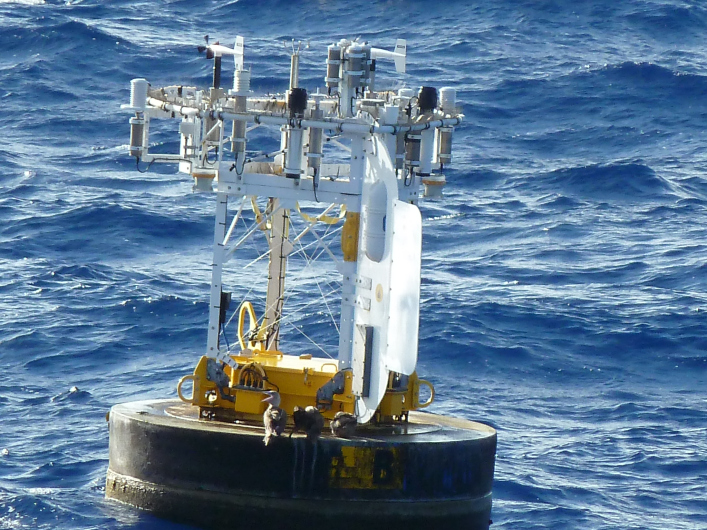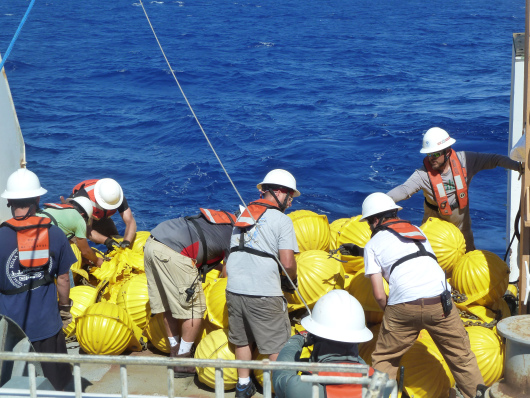NOAA Teacher at Sea
Samantha Adams
Aboard Hi’ialakai
July 25 – August 3, 2017
Mission: Woods Hole Oceanographic Institution (WHOI) Hawaii Ocean Time-series Station deployment (WHOTS-14)
Geographic Area of Cruise: Hawaii, Pacific Ocean
Date: Monday, 31 July 2017
Weather Data from the Bridge:
Latitude & Longitude: 22o45’N, 157o45’ oW. Ship speed: 0.8 knots. Air temperature: 27.9oC. Sea temperature: 27.3oC. Humidity: 72%.Wind speed: 11.2 knots. Wind direction: 93 degrees. Sky cover: Few.
Science and Technology Log:

The WHOTS-13 buoy after a year at sea. These three red-footed boobies will lose their perch soon!
It’s deja vu all over again! The WHOTS-14 buoy is stable and transmitting data, and all the in situ measurements necessary to verify the accuracy of that data have been taken. Now it’s time to go get the WHOTS-13 buoy, and bring it home.

Diagram of the WHOTS-13 mooring. Image courtesy of the University of Hawaii.
The process of retrieving the WHOTS-13 buoy is essentially the same as deploying the WHOTS-14 buoy — except in reverse, and a lot more slimy. Take a look at the diagram of the WHOTS-13 buoy (to the left), and you’ll notice that it looks almost identical to the WHOTS-14 buoy. Aside from a few minor changes from year to year, the configuration of the buoys remains essentially the same… so the three and a half miles of stuff that went into the ocean on Thursday? The same amount has all got to come back up.
At 6:38AM HAST, a signal was sent from the ship to the acoustic releases on the WHOTS-13 buoy’s anchor. After a year under three miles of water, the mooring line is on its way back to the surface!
From the time the signal was sent to the acoustic releases on the anchor to last instrument coming back on board, recovering the WHOTS-13 buoy took 9 hours and 53 minutes.
Personal Log:
Now that I have witnessed (and participated in, however briefly) both a buoy deployment and retrieval, one of the things that impressed me the most was how well coordinated everything was, and how smoothly everything went. Both deployment and retrieval were reviewed multiple times, from short overviews at daily briefings (an afternoon meeting involving the ship’s officers, crew and the science team) to extensive hour long “walk throughs” the day before the main event. Consequently, everyone knew exactly what they were supposed to be doing, and where and when they were supposed to be doing it — which lead to minimal discussion, confusion and (I assume) stress. Each operation ran like a well choreographed dance; even when something unexpected happened (like the glass ball exploding on deck during deployment of the WHOTS-14 buoy), since everybody knew what the next step was supposed to be, there was always space to pause and work through the problem. Communication is most definitely key!
The other thing that really made an impression was how much emphasis was placed on taking breaks and drinking enough water. It was hot, humid and sunny during both deployment and recovery, and since Hi’ialakai had to be pointed directly into the wind during the operations, there was virtually no wind on the working deck at all. I’ve always thought as the ocean as a place you go to cool off, but, at least for these few days, it’s been anything but! With apologies to Coleridge: “Water, water, everywhere, nor any place to swim!”
Did You Know?

A tangled mess of anything can be called a wuzzle. For example: “I don’t know how my headphones got into such a wuzzle.” The mess of glass balls on the deck is most definitely a wuzzle.
Share this:




